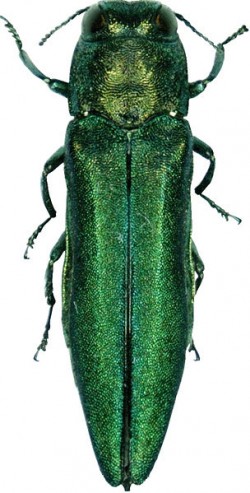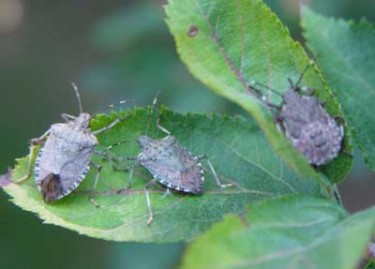Swing, batter!

On a residential street in Anywhere, U.S.A., a colony of invasive emerald ash borers swarms inconspicuously on the periphery. Their sights are set on a row of lush, mature ash trees that line the quiet street. These trees have seen their community through World War II and the Civil Rights Movement, but meeting the ash borers will mark their final stand.
These tiny, iridescent emerald insects are native to Asia and they’re vividly green like the foliage they consume. The real damage occurs, though, when their larvae hatch, bore into a tree’s bark, and feed on its tissues. The squiggly tunnels they carve inside trees are fatal, diverting and bisecting the flow of nutrients and water the trees depend upon. This visually unassuming insect has destroyed tens of millions of ash trees in the United States, and the Washington Post recently reported that another 50 million ashes have been removed preemptively from public spaces by municipalities that don’t have the resources to care for infected trees.

Unless you live on a street lined by new stumps or in a city whose parks are now without shade, you might be unfamiliar with this scenario. This type of ecological threat can seem intangible and distant from our day-to-day. But that may change—these invasive critters could plow past ash trees and into mainstream America’s conscience through our oldest, most cherished pastime: baseball.
“A huge portion of baseball bats are made from ash trees that grow in a very narrow range. Trees between southern Pennsylvania and central New York grow at the perfect rate needed to produce baseball bats of exactly the right density, and that range is infested,” said Patrick Tobin, assistant professor at College of the Environment’s School of Environmental and Forest Sciences.
Tobin fell for the scientific study of insects in a course he took during his last semester of undergrad, and went on to earn a master’s and PhD in entomology. After nearly 12 years at the U.S. Forest Service’s Northern Research Station in West Virginia, where he honed in on invasives, today Tobin studies and teaches invasion ecology and forest entomology at the UW.
Tobin is currently working on several early-detection projects as well, examining chemical lures, trap types, and trap colors believed to be those perceived by adult emerald ash borers during their host selection process. A baseball fan himself, he notes that Major League Baseball and its top provider of baseball bats—seemingly unlikely partners to science—are pouring big money into research on the emerald ash borers.
Our own backyards

Closer to home, brown marmorated stink bugs—a nonnative species identifiable by a black and white pattern along the edge of their wing covers—are already in Washington state. These ultra-generalists use a functional mouthpart similar to a mosquito’s to pierce their food and suck up its juices.
“In 2010, these stink bugs destroyed 25 percent of the apple crop in Pennsylvania. Now they’re in Washington, the nation’s number one producer of apples,” said Tobin. “Agriculture is their buffet—counties like Yakima and Walla Walla are basically calling them in.”
Although these juice-drinking bugs don’t alter the taste of the fruits and vegetables they overtake, the resulting aesthetic damage leaves them unsellable.
Prior to UW, Tobin had been developing various pilot studies on the brown marmorated stink bug and is optimistic that he and his graduate students will be able to pick up on and continue those studies. These particular insects could mushroom into a widespread problem in Washington, he says, which has been somewhat spared from invasive insects compared to other states.
Pony up for invasives
“You’re paying for the cost of invasive species now, today, and sometimes those costs are hard to quantify,” said Tobin. “It’s the emotional cost of seeing a tree your family loves being chopped down because of emerald ash borers and it’s paying an extra 5 cents for your apple at the grocery store because of a smaller harvest caused by brown marmorated stink bugs.”
And there’s the rub: implications associated with invasive species aren’t just ecological. They’re shaping the way we experience the world around us on multiple fronts, including economic and cultural. Whether we’re aware or not, the cost of mitigating invasives’ entry gets passed along to the consumer. When nonnative species destroy crops and diminish yields, demand rises, and our grocery bills get higher. And in addition, as we become a more globally connected society and move species around the world through trade, our cities suffer too: they are losing their urban canopies, which serve as community meeting-places, regulate temperatures seasonally for nearby buildings and residences, and clean the air. And even baseball, an American tradition enjoyed by millions—from Little League to the MLB—is caught in the crosshairs.
Asian markets really opened up in the late-90s, giving Asian insects an opportunity to spread farther out. Since then, the U.S. Department of Agriculture has been revisiting its “enemy release” program, an approach that aims to reduce invasive species by adding one of their natural enemies into the ecosystem. This tactic is currently being used for both the emerald ash borer and the brown marmorated stink bug. Despite strict protocols and the years of testing that go along with this kind of biological control, some folks are uneasy with the idea of releasing a second, often invasive insect into an area already overridden by another. Tobin says that improved high-risk trade route monitoring can help detect invasive insects early enough to stop them, while increased reliance on local or U.S.-produced goods may diminish the amount of nonnative pests that make it into the United States.

